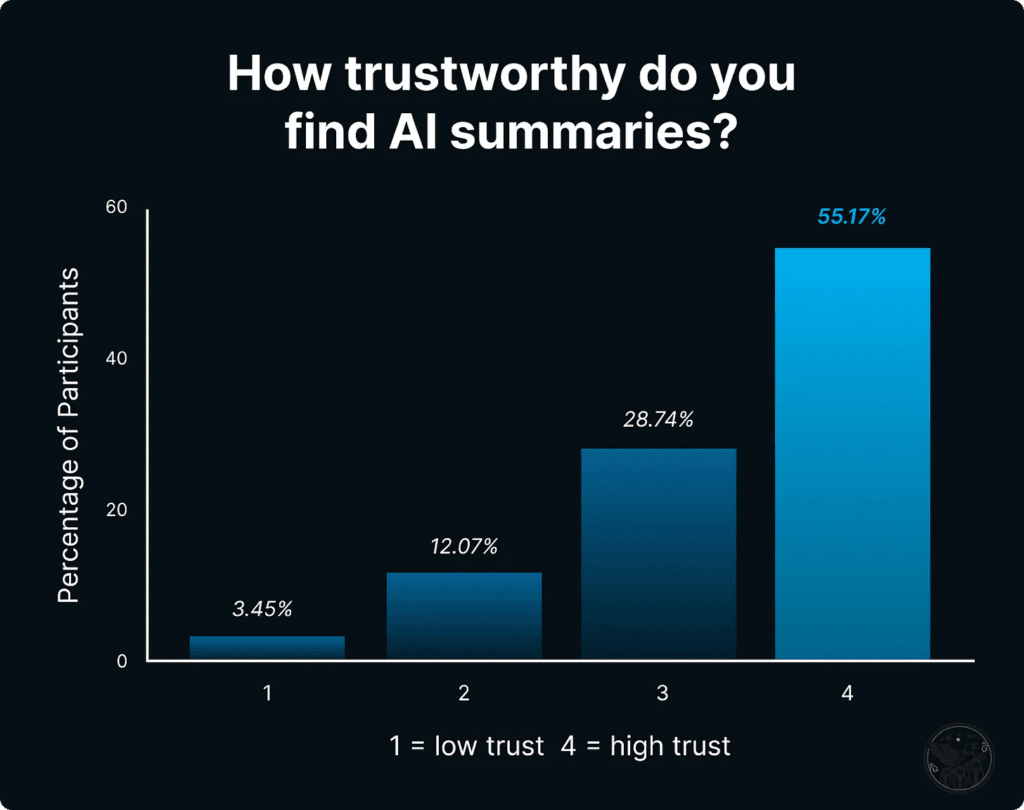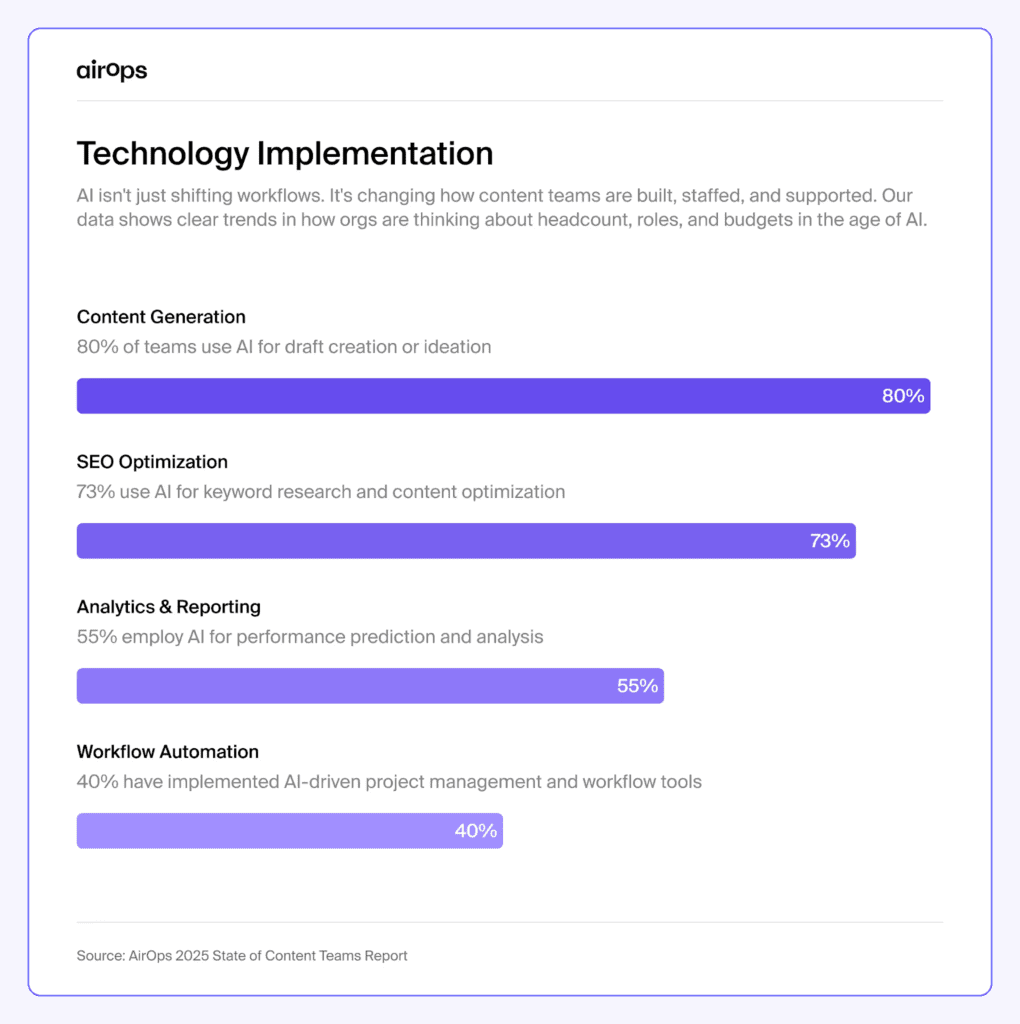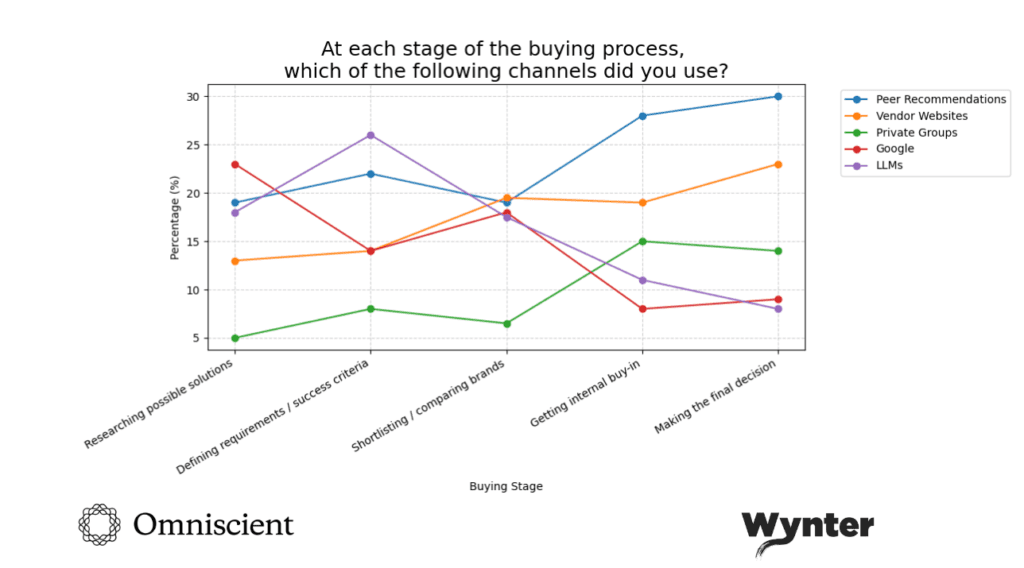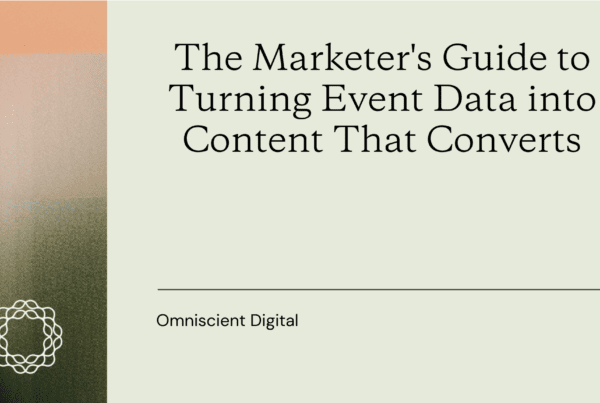
In 2025, a pressing challenge for marketers is standing out in the sea of noise. AI has given brands the ability to produce content at a rapid rate, flooding every channel and strengthening competition. The conversations among leaders now center on what comes next.
Many leaders want a playbook for what’s coming next. In a recent newsletter, Alex Birkett, co-founder of Omniscient called this phenomenon marketing whiplash, where constant volatility and noise means “The more you look, the less you see.”
Teams remain fearful of choosing the wrong tactics, unsure how to execute new strategies even when their goals are solid, and hampered by measurement and tooling not yet ready for the new AI era.
That’s where original marketing research comes in.
It gives brands clarity in uncertainty, helping them differentiate content, establish authority, and drive data-backed strategies instead of chasing trends blindly.
It’s an authoritative strategy that centers your brand as the source material, and the insights you surface can be leveraged in many different campaigns and formats, from social media to podcasts, digital PR campaigns, webinars, blog posts, and more.
I’ve compiled my favorite research examples from the past year, each one offering a unique perspective on marketing trends in 2025, including AI adoption, buyer behavior, and team dynamics. These reports inspire original thinking, support smarter decisions, and pave the way for the future of digital marketing.
1. Growth Memo’s UX Study of AI Overviews

When I was first thinking about how I wanted to design and run my own studies, this was one of the projects that shaped how I think about research.
A lot of studies rely on surveys. They are easy to execute and quick to analyze, but they come with a built-in limitation: human bias. People often answer based on what they think they would do, not what they would actually do. If you ask, “Which channel would you use to find information on X?” the response might not match real-world behavior at all.
This study went further. It overcame that heuristic gap by observing how people genuinely behave and react in the moment. That combination of behavior and sentiment makes the insights feel grounded. It takes the respondent out of their head and into real context. It reminded me of those early ethnographic studies from school where brands watched morning routines to uncover authentic habits.
The scope impressed me too. Twenty-nine hours of user recordings and a serious investment to truly understand how people engage. It is the kind of work that pushes me to challenge what is possible and get creative with my methodology and goals.
Methodology
Researchers analyzed 29 hours of video recordings from 69 U.S. users, each prompted to complete eight real-world search tasks. Some prompts included Google AI Overviews (AIOs) while others did not. Every click, scroll, dwell time, and comment was reviewed to understand engagement differences between AIOs and traditional search results.
Key Data
- The median scroll depth was only 30% when users were presented with an AIO.
- 58% trusted AIO answers immediately when the source was familiar.
- 18% of users left the AIO to verify its information on Reddit, Youtube, or other organic results.
Takeaways for Marketers
- Clicks will decline as AI Overviews reduce exploratory search behavior. AI-driven marketing trends now demand new KPIs like share of AI search and brand citation rate.
- Your brand’s authority reigns supreme. Recognition drives trust and engagement in this evolving AI-powered search landscape.
2. AirOps’ State of Content Teams in 2025

This report is tightly focused, zeroing in on a thin scope: content operations in the age of AI. It’s tempting to try to cover every topic you want to understand all at once; I know that from experience. But good research knows when to narrow its focus and deliver clarity to something still taking shape.
It asks the right questions: What’s working, what isn’t, how are teams changing, what are they using AI for? That approach doesn’t just make the research interesting, but actionable, especially in a transitional time for marketers.
AI’s impact on marketing looks different in every niche, so good research in this space needs to be targeted, specific, and grounded in real context. This study acknowledges nuance and reflects the reality of a changing environment.
Documenting movement in real time, it becomes the kind of research with high repeatability, worth revisiting quarter after quarter to track how the landscape changes.
Methodology
In a survey of 144 content leaders, they looked to understand where teams stand with AI adoption today, including successes, failures, and future investments.
Key Data
- 48% of teams are adding new roles for AI-specific tasks like content engineering.
- 17% of teams have fully integrated AI into all content workflows, but the majority, 38%, have partial integration, lacking alignment across teams.
- 82% say their biggest challenge is “maintaining quality”, and 51% report a lack of internal team skills related to AI workflows and use cases.
Takeaways for Marketers
- AI adoption is uneven, but acceleration is inevitable. Digital marketing teams that integrate AI effectively will outpace laggards in speed and scale.
- Quality still wins. As automation scales, credibility and strong editorial oversight will define brand trust.
3. Omniscient x Wynter’s B2B Buyer Behavior Research

This research asks a hard-hitting question and looks at the current AI marketing landscape from a refreshing angle. I see it as a model for studying emerging trends: stay focused, ask the questions no one else is asking, and tell a story that helps people understand what’s actually happening beneath the surface.
A lot of studies focus on how marketers are adapting, planning, and experimenting. But this one flips the perspective. Instead of studying the people creating the campaigns, it looks at the audiences they are trying to influence: what they’re thinking, feeling, and doing as AI becomes part of the buying process.
What stands out is how intentional the study feels. Every chart, quote, and data point adds something meaningful. The findings bring real clarity to how B2B buyers make decisions and where brands truly earn trust. It’s grounded in qualitative depth, and real voices always reveal more than single-select answers ever can.
Wynter’s platform attracts thoughtful, high-quality respondents who provide depth, not one-sentence answers, turning data into genuine perspective rather than surface-level sentiment.
Methodology
Using the Wynter platform to survey 100 B2B SaaS decision-makers who have made a business purchase in the past 6-12 months, they asked about channels used at each stage, how vendors build trust, and what factors go into the final decision.
Key Data
- Google still dominates early research for 55% of buyers, followed by LLM search used by 42% of respondents in the first step.
- Peer recommendations drive 27% of initial research and 85% of final trust decisions.
- 37% of buyers stop using an LLM after initial research, and 25% would never use an LLM to make their final decision.
Takeaways for Marketers
- Buyers look for human inputs in the process; peer recommendations, third-party reviews, and real case studies build trust – all components that cannot rely on your brand’s inputs alone.
- Transparency beats perfection. Customers want to know how you work with them, how you will solve their specific problems, and what you’re best at, rather than hearing you can “do it all”.
4. Mutiny’s State of Sales and Marketing Alignment

This report is funny because it looks at issues between teams: how they should be aligned, but often aren’t. You can actually feel the friction in the data. Team dynamics are one of those topics that seem almost taboo; people don’t usually talk publicly about tension or misalignment with coworkers. That’s what makes this study so refreshing. It puts a spotlight on something everyone experiences but few address directly.
It’s also just beautiful. The UX is incredible. As you scroll, the data feels alive. It’s clear, colorful, and easy to follow. The flow makes it feel more like an interactive story than a static report. It’s not weighed down by long paragraphs or filler text, which makes it fun to learn from.
There are two key things about reading research: people need to grasp the main idea quickly and stay engaged throughout. Attention-grabbing visuals, clear themes, and strong statistics draw readers in. This report nails that. You can skim it and still understand the big takeaways without losing focus or energy.
It’s a great reminder that good research isn’t just about collecting the right data, it’s about communicating it well. From a marketing and UX perspective, the experience matters as much as the insights. When presentation, storytelling, and usability come together, research transforms from information into influence.
Methodology
They surveyed 500 sales and marketing leaders (50/50 split) at B2B companies in the U.S. to understand collaboration between teams, alignment’s impact on pipeline, and go-to-market strategies.
Key Data
- Aligned teams are 2.3x as likely to exceed their revenue target.
- 70% of teams say the departments are aligned with overarching goals, but report friction in day-to-day activities.
- 81% of sales and marketing team members would replace their counterparts and only 34% feel positive after meeting cross-functionally.
Takeaways for Marketers
- AI is blurring functional boundaries, making cross-functional collaboration an emerging marketing trend.
- They must share data, goals, and planning processes to provide consistent customer experiences, improve team relationships, and drive pipeline growth.
5. ActiveCampaign’s Analysis of AI in Marketing

This report takes a more traditional approach, and that’s exactly why it works. It doesn’t try to be unconventional or experimental; instead, it shows how solid, quantitative research, done well, can deliver real value. If you’re newer to research, this is the kind of project that proves fundamentals still matter.
It’s large in scale, structured, and clear. It doesn’t just say that “AI saves marketers money,” it tells you exactly how much. It breaks respondents into segments and compares them, which is one of the most effective ways to surface patterns and actionable insights.
The framework it builds, showing stages of AI use and tying findings back to those stages, is also smart. It turns data into a usable structure that helps brands see where they stand and what steps to take next. That kind of clarity is key in both research and marketing: when people can see themselves in the data, the message resonates.
Methodology
In collaboration with Talker Research, they surveyed 1,000 U.S. marketers and business owners at organizations with fewer than 500 employees.
Key Data
- AI is saving an average of 32.5% of marketers’ weekly hours and $4,739 per month in operational costs.
- Only 23% of respondents incorporate AI into the full marketing funnel, with many stopping its use before the data validation stage.
- 15% believe they are AI experts, and this group is twice as likely to feel confident in the quality of their work.
Takeaways for Marketers
- ActiveCampaign’s High-Performance Marketing Triad – Imagine, Activate, and Validate – creates a strategy for marketing teams to thrive in the AI era, moving from experimentation to optimization.
- AI’s next frontier is in measurement and predictive analytics, not just generation. The most effective teams will integrate AI across every stage, from ideation to validation.
Why Original Research Matters
Original research has quietly become one of the most meaningful differentiators in marketing.
It gives brands something rare in a landscape of repetition: a voice that contributes rather than echoes.
1. It builds real authority
When your team publishes data that others cite, you move from an observer to a participant in the larger conversation. That shift doesn’t happen through volume; it happens through value. The credibility that comes from producing useful, verifiable insights compounds naturally through brand mentions, backlinks, and AI citations.
Original data draws attention because it’s genuinely helpful, not because it’s perfectly optimized. That kind of organic visibility tends to last much longer than quick-hit tactics ever do.
2. It extends the life of your ideas
A single research project can inform months of storytelling. A well-designed study becomes a foundation for articles, social posts, webinars, and campaigns – a source of truth you can revisit rather than reinvent.
It gives your team a shared narrative to build around, creating clarity, consistency, and efficiency across channels.
3. It clarifies thinking and alignment
Doing research forces a pause. It creates a chance to examine assumptions and ask hard questions: What do we actually know? What do we need to learn?
That process often sparks sharper strategy and better creative ideas. It aligns teams around insights rather than opinions, and that alignment tends to carry forward into how decisions are made and campaigns are measured.
As marketing continues to evolve, original research offers a robust playbook that frames your brand as the authoritative source, gives you endless vehicles for repurposing and leverage, and helps position your brand for greater visibility in AI search, SEO, and beyond.. It turns uncertainty into insight, and data into direction.
It’s a tactic that earns trust not by saying more, but by knowing more.


